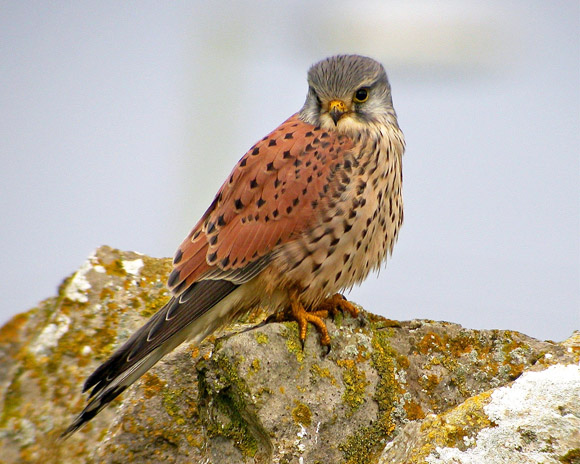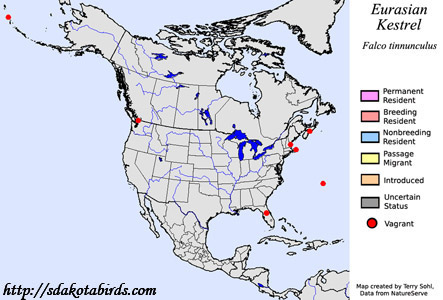| Length: 13-15 inches | Wingspan: 28-32 inches | Seasonality: Non-resident in South Dakota |
| ID Keys: Ruddy brown upperparts with spots, buffy underside with black streaks, black-tipped tail, blue-gray crown on male | ||
 The
Eurasian Kestrel (also known as the Common Kestrel) is the Eurasian
equivalent to the American Kestrel,
although it is a somewhat larger bird. Females are noticeably larger than
males. While both sexes are similar in overall appearance, male Eurasian
Kestrels tend to have fewer dark spots and streaks, and also sport a
bluish-gray crown that is lacking on females. They are found through much of
temperate Europe and Asia, from western Europe, eastward through Asia
through Russia, China, and Japan, along with populations in north Africa. It
is thought that Kestrels can see light in the ultraviolet spectrum, allowing
them to see reflected light from urine trails of their typical small rodent
prey. In North America they are known from a handful of scattered sightings
that have occurred near both the Pacific and Atlantic coasts.
Sightings include birds in the far western Aleutians, British Columbia, Nova
Scotia, Florida, and Cape Cod.
The
Eurasian Kestrel (also known as the Common Kestrel) is the Eurasian
equivalent to the American Kestrel,
although it is a somewhat larger bird. Females are noticeably larger than
males. While both sexes are similar in overall appearance, male Eurasian
Kestrels tend to have fewer dark spots and streaks, and also sport a
bluish-gray crown that is lacking on females. They are found through much of
temperate Europe and Asia, from western Europe, eastward through Asia
through Russia, China, and Japan, along with populations in north Africa. It
is thought that Kestrels can see light in the ultraviolet spectrum, allowing
them to see reflected light from urine trails of their typical small rodent
prey. In North America they are known from a handful of scattered sightings
that have occurred near both the Pacific and Atlantic coasts.
Sightings include birds in the far western Aleutians, British Columbia, Nova
Scotia, Florida, and Cape Cod.
Habitat: Found in a variety of semi-open habitats, including grasslands, agricultural lands, and semi-arid regions. They can also be found in semi-forested areas such as open woodlands or near woodland edges. Some have adapted well to a human presence, and they can be found along transportation corridors and suburban areas.
Diet: Feeds on large insects, small mammals, small birds, and invertebrates such as earthworms.
Behavior: They are usually solitary birds outside of the breeding season, although while in migration they may form small loose groups of up to a dozen birds. Hunting methodology is often done by hovering, with birds facing into a wind with occasional wing flapping, or through continuous flapping while they look down for prey. They will also use prominent perches and peer down to the ground, swooping out to grab small rodent that it spots. On occasion they will also use a ground-hugging flight, flying low to the ground and surprising prey that it stumbles across.
Nesting: The nest site of a Eurasian Kestrel may be in a tree cavity, a crook in a tree, on an abandoned building, on a cliff ledge, or in the abandoned nest of another species (nests of Corvid species are often used). They do not build their own nest, although they may modify a location by adding a few sticks or other material. Three to six eggs are typically laid, with the female doing most of the incubation. Incubation takes about 30 days. After the eggs hatch, for the first week or two, the female primarily stays with the hatchlings, feeding them food that is brought by the male. Later, both parents may hunt and feed the young. Young fledge after 30 to 40 days.
Song: Has a harsh kee-kee-kee call. Most vocalization is done around the nest site, and they are mostly silent away from it.
Migration: Migratory behavior is dependent upon location. In the more temperate and semi-tropical portions of their range, Eurasian Kestrels are primarily permanent residents. However, those birds in the northern part of their range are migratory, moving south for the winter.
Interactive eBird map: Click here to access an interactive eBird map of Eurasian Kestrel sightings
Similar Species: Similar in overall structure and appearance to the American Kestrel, although the Eurasian Kestrel is larger, and the American Kestrel has an additional face stripe that frames the cheek.
Conservation Status: Populations are likely declining. The primary threat is likely habitat loss, both with agricultural intensification in Europe and Asia, but also land use change in Africa. Other threats include the impacts of some pesticides, energy development such as wind farms, and direct hunting activity. However, overall Eurasian Kestrels are found over a very wide geographic range and are common in many locations. The IUCN lists the Eurasian Kestrel as a species of "Least Concern".
Further Information: 1) BirdLife International - Common Kestrel
2) European Raptors - Eurasian Kestrel
3) Audubon Guide - Eurasian Kestrel
Photo Information: Photo taken on November 10th, 2006 at Glamorgan, Wales, in Great Britain - Photo by Paul Roberts - Photo licensed under Creative Commons Attribution NonCommercial 2.0 Generic License
| Click below for a higher-resolution map |
 |
| South Dakota Status: Non-resident in South Dakota |
Additional Eurasian Kestrel Photos (coming soon!!)
